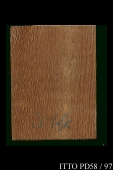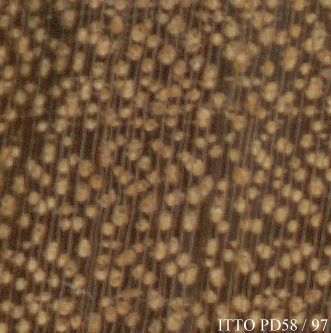
RED BALAU, BALAU, SAL (Shorea robusta)
Trade Name
Red Balau, Balau, Sal
Scientific Name
Shorea robusta Gaertner f.
Family
DIPTEROCARPACEAE
Common Names
; Sakwa (Nepal); Sal (India)
Description Of The Tree
Botanical Description
A large deciduous tree, usually gregarious, growing 18-30 m in height and 1.5-2.0 m in girth. The bark is 2.5-5.0 cm thick, rough dark brown with conspicuous vertical furrows, be used for tanning, brown dye and ropes. Tree yield a natural resin (Sal damma
Natural Habitat
S. robusta is the dominant species in sal forest.
Natural Distribution
The trees occur in northern and central India, sub Himalayan region (1200-1500 m) to Nepal and south of the Ganga.
Plantations Available?
Viability of the seed is very short. It seldom germinates two weeks after its collection. The problem of the Sal seedling and the regeneration of some Sal forests come to one's mind.
Non Timber Uses
The wood contains a transition zone which is looks like heartwood. The quality of Sal varies from place to place. The fact is that the anatomical structure of Sal wood varies to a great extent.
Wood Identification
Anatomic Description Of Wood
Vessels per mm2 5 to 20. Wood diffuse porous. Tyloses common. Tangential diameter of vessel lumina 200 micras or more (large). Vestured pits. Vessel-ray pits reticulate and/or foraminate. Simple perforation plates. Intervessel pits small, 7 micras or less. Paratracheal axial parenchyma scanty and/or vasicentric. Axial parenchyma aliform. Axial parenchyma in marginal or in seemingly marginal bands. Axial parenchyma bands more than 3 cells wide. 4 to 10 rays per mm (medium). Body ray cells procumbent with one row of upright and/or square marginal cells (Kribs-III).
-
 Wood Macro Photo Tangential Plane
Wood Macro Photo Tangential Plane
-
 Wood Micro Photo Of Transversal Section
Wood Micro Photo Of Transversal Section
Availability
Cites Status
Unrestricted
General Wood Description
Odor
-
Color
Heartwood is light brown to brown colored, and turning reddish brown on exposure. Sapwood when fresh is pale white with a brownish tinge, narrow.
Grain
Interlocked grain with ribbon bands.
Texture
Varies from moderately coarse to coarse.
Luster
-
Natural Durability
The wood, especially heartwood, is very durable. It is not attacked by white ants and fungi for a long time.
Natural durability index (1= Very high durability, 7=Vey low durability)
2
Internal Growth Stresses
-
Silica Content
Silica Content: -
Resistance To Impregnation
Sapwood is easy to be penetrated by preservatives, while the heartwood is impermeable.
Wood Physical Properties
Basic Density or Specific Gravity (O.D. weight/vol. green) (g/cm³)
0.76
Air-dry Density (Weight and volume at 12%MC) (g/cm³)
0.86
Total shrinkage Tangential (Saturated to 0%MC) (%)
9.1
Total shrinkage Radial (Saturated to 0%MC) (%)
4.1
Drying Defects
Ease of Drying: Vutu can be kiln dried from the green condition without difficulty using the recommended schedule,with some surface checking or slight warp the only problems. Drying Defects: 25 mm board: Kiln drying from green to 12% m.c. requires 4~5 days, reduced to 1 1/2 days after preliminary air drying to 25% m.c..Ahigh humidity stress relief treatment,tentatively 24 hours should follow drying 50 mm stock :Kiln drying from green to 12% m
Recommended Dry Kiln Schedule
UK-B; UK-G
Dimensional stability ratio (Total Tangential Shrinkage %/Total Radial Shrinkage %)
2.2
Wood Chemical Properties
Wood Mechanical Properties
Bending Strength (MOR),12%MC (kgf/cm²)
1216
Stiffness (MOE) 12%MC (kgf/cm²)
156100
Workability
Sawing
High resistant to cut. The wood has known as a difficult timber to saw and to work with. Air-dried timber is more difficult to saw compared than the green one. Red balau is usually easier to work than Balau.
Rotary Veneer Cutting
S. robusta was found to be unsuitable for the production of veneer and plywood.
Sliced Veneer
S. robusta was found to be unsuitable for the production of veneer and plywood.
Blunting Effect
-
Machining
Varies from moderately difficult to difficult. While working with machine picking up of fibers often takes place and it is also difficult to get a smooth surface.
Moulding
-
Boring
Easy to slightly difficult.
Mortising
-
Gluing
Uncertain but tends to poor.
REFERENCED USES
End Uses Summary
EXTERIOR GENERAL, bridges, poles, rails, HOUSING GENERAL, beams, joists, flooring, frames, FURNITURE AND CABINETS, TOOLS, tool handles, CONTAINERS, chemical storage, truck flooring, NAVAL CONSTRUCTION, boats, OTHER AND MUSICAL INSTRUMENTS, wheel
Exterior General
- 1 - Tabela de resultados de ensaios fisicos e mecanicos
Bridges
- 2 - 25 madeiras da amazonia de valor comercial, caracterizacao, macroscopica, usos comuns e indices qualificativos
Poles
- 3 - Estudo dendrologico e determinacao das caracteristicas fisicas e mecanicas do genipapo (Genipa americana)
Rails
- 6 - Physical and mechanical properties of Eucalyptus deglupta Blume grown in Costa Rica
General Housing
- 10 - Silica in Timbers
Beams
- 11 - Prospect: The wood database
Joists
- 12 - Tropical timbers of the world. Part I-Tropical American Species
Flooring
- 14 - Handbook of Hardwoods
Frames
- 16 - Woods of the World
Furniture Cabinets
- 21 - Tropical timbers of the world. Part III-Southeast Asian and Oceanian Species.
Tools
- 42 - Utilización Industrial de Nuevas Especies Forestales en el Perú.
Tool Handles
- 43 - Maderas de Bolivia (Características y Usos de 55 Maderas Tropicales)
Containers
- 50 - Properties of imported tropical woods
Chemical Storage
- 52 - Propiedades mecanicas y asociadas del pino insigne (Pinus radiata d.don)
Truck Flooring
- 54 - Bulletin of the Government Forest Experiment Station N.157: Identification of Tropical Woods
Shipbuilding
- 55 - Tropical Timber Atlas of Latin America
Boats
- 56 - Manual de Identificación de Especies Forestales de la Subregión Andina.
Wheels
- 75 - Tropenholzer
Please Provide Information To View Producer Information